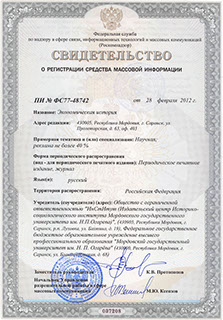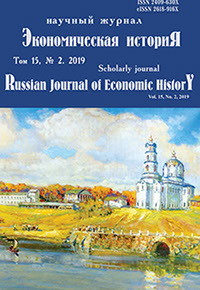Экономическая историЯ
Russian Journal of Economic History
ISSN 2409-630X (Print)
ISSN 2618-916X (Online)
Expert board:
- Scientific Council of RAS on economic history;
- Research and Educational Center «The economic history of Central Russia and the Middle Volga region» of Ogarev Mordovia State University;
- Center of Economic History of Lomonosov Moscow State University
Navigation
Certificate of registration

ISSN 2409-630X (Print), ISSN 2618-916X (Online)
DOI: 10.15507/2409-630X.045.015.201902.166-175
УДК 9(с145)
Rafail V. Shaydullin1, Ilgizar R. Kaydarov2
1 Institute of Tatar encyclopedia and regional studies Academy of Sciences of the Republic of Tatarstan (Kazan, Russia), e-mail: srv60@yandex.ru;
2 Kazan higher tank command Red banner school (Kazan, Russia), e-mail: luciakaidarova@mail.ru
PEASANT (FARMER) ECONOMY OF TATARSTAN: FEATURES OF FORMATION AND FIRST RESULTS (1990–2010-ies)
Introduction. The effectiveness of market processes in one of the leading regions of the Russian Federation – the Republic of Tatarstan is determined by the level of development of various forms of entrepreneurship and their competitiveness. The increased responsibility of the Tatarstan leadership for the results of regional socio-economic development stimulates the desire to strengthen and expand the position of small and medium businesses, encourages regional authorities to pay special attention to the accelerated institutionalization of peasant (farmer) farms as one of the promising models of transformation of the agricultural sector of the Republic. The Institute of peasant (farmer) farms is the result of post-perestroika Russian reforms, the degree of its rationality and efficiency depends not so much on the scientific and practical elaboration of the legislative and institutional-market foundations, but on the depth of understanding of the state structures and the rural majority of the need and specificity of these economic entities. In this regard, the main purpose of this work is the scientific and practical analysis of the formation and development of peasant (farmer) farms in Tatarstan in the context of determining the main socio-economic indicators in relation to the study area; identify the parameters of statistical analysis and description of industries that design this form of management. Materials and Methods. The content of the scientific article is based on the materials of current sources coming from various departments and periodicals, consolidated data of publications of the statistical office of Tatarstan, as well as on the literature of historical and economic nature. The research is based on traditional methods of Russian historical science: problem-chronological, comparative-historical and systemic. These methods have been successfully tested in the process of determining the regional characteristics of the development of peasant (farm) farms. When processing quantitative data the statistical method is used; for a more detailed immersion in the subject of the study used micro-historical approach. Results. The study of agrarian sector of economy of Tatarstan 1990–2010 given the historical and economic characteristics of the process of institutionalization of the peasant (farmer) farms. In particular, in a comparative perspective, the share of peasant (farm) farms in the structure of regional gross income is considered. It is established that the main branches of economic activity of Tatarstan farming were crop and livestock, and the latter direction was more promising. Discussion and Conclusion. The level of development of small business in Tatarstan, including peasant (farmer) farms, currently provides an opportunity to diversify, focusing on the market and conditions of production and sales. In conditions of latent developing degradation of rural areas (disappearance of villages, aging and reduction of the rural population, destruction of socio-cultural infrastructure, etc.), peasant (farmer) farms, along with personal subsidiary farms of the population, become a kind of means of increasing interest in various forms of small business, as well as contribute to the growth of village-forming potential in the agricultural socio-cultural space of Tatarstan. At the same time, despite the regional authorities understanding of the importance of the final goals and development strategy of farming, there is no system-forming form of support for peasant (farmer) farms in the Republic. Moreover, the creation of an image of the attractiveness of peasant farming is mainly associated with individual activities or PR campaigns to create a favorable investment image, climate. The results obtained in the course of this study are prerequisites for further historical reconstruction of farm daily life in the context of deepening the study of the experience of individual Russian regions, its applied analysis.
Keywords: Russian farming, Tatarstan, agricultural sector, rural population, peasant (farmer) farms, personal subsidiary farms, economic activity, growth indicators, gross output.
For citation: Shaydullin R. V., Kaydarov I. R. Peasant (Farmer) Economy of Tatarstan: Features of Formation and First Results (1990–2010-ies.). Ekonomicheskaya istoriya = Russian Journal of Economic History. 2019; 15(2): 166–175. (In Russ.). DOI: 10.15507/2409-630X.045.015.201902.166-175.
© Ogarev Mordovia State University. History and Sociology Institute, 2017
68, Of. 411, Bolshevistskaya St., 430005, The editorial office of the scholarly journal «Russian Journal of Economic History»
Tel.: (8342) 24-25-90; 27-07-11, Fax: (8342) 24-25-90, E-mail: jurnal-econom-hist@isi.mrsu.ru
Designed by A. Napalkov, Email: napalkov@isi.mrsu.ru

